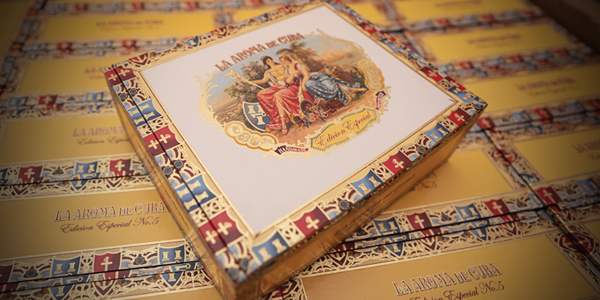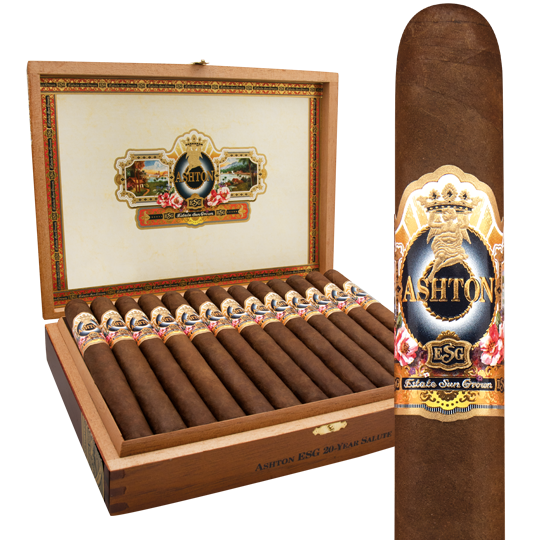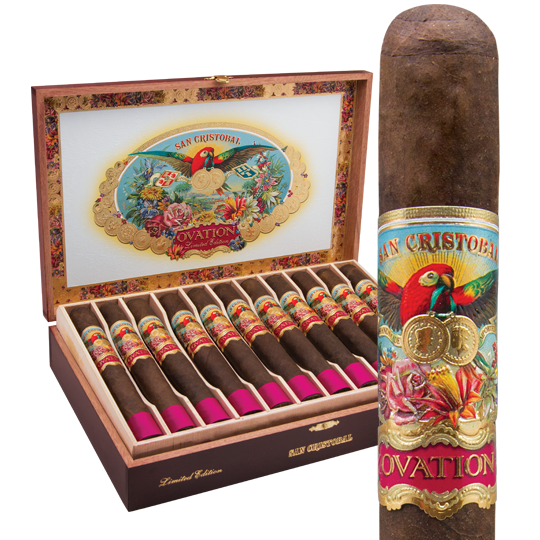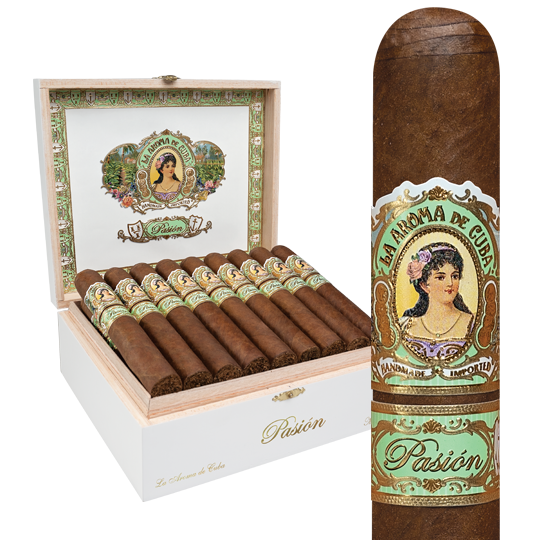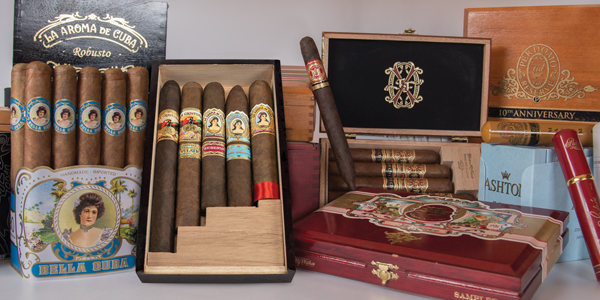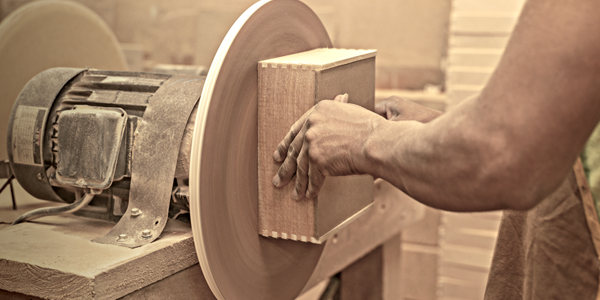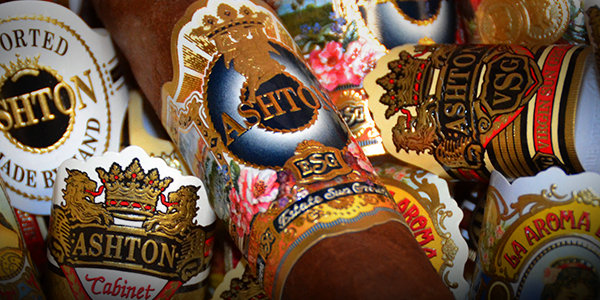The Appeal of Unique Cigar Packaging
Because cigars are made from tobacco, they are subject to the restrictive and often punitive rules commonly used to regulate cigarettes and vaping products. Fortunately, U.S. District Judge Amit P. Mehta recently nullified the FDA’s requirement that cigar packaging be covered by obtrusive warning labels with stringent and costly specifications. He defended his ruling with evidence that “premium cigars have different usage patterns than other cigar and tobacco products, they are almost never used by youth, and they are instead used by older, higher income, and better educated consumers.”
Mehta’s decision preserves the authentic, old world impression cigar boxes and bands communicate. Imagine obscuring the beautiful detail on the top of a box of La Aroma de Cuba cigars with an obnoxious warning banner that covers 30% of the surface.
A Bit of History Behind Cigar Boxes
More thought goes into the boxes and bands in premium cigar packaging than most other consumable products. In addition to the cigar factories where cigars are rolled, the biggest cigar brands operate factories dedicated to making cigar boxes. Artists, woodworkers, and designers collaborate to make cigar boxes with intricate detail, shape, and color. Cigar packaging has come a long way in the past 200 years. The H. Upmann brand was the first to innovate by packaging its cigars in boxes in the mid-1800s. Not only did the first cigar boxes preserve the product, they proved effective tools for branding and marketing purposes.
The industry-wide adoption of cigar boxes, however, grew out of none other than taxation. Prior to the Civil War, few brands were packed in boxes. Cigars were shipped in barrels containing 2,500 cigars or more, making the process of tracking and taxing them a daunting task for revenue agents. By 1865, federal laws were passed requiring cigars be packaged in wooden boxes containing 25, 50, 100, or 250 cigars. The IRS could easily stamp these predetermined quantities when the duties had been paid.
In the Eye of the Beholder
Today, most cigars are packaged in boxes or bundles of 20 or 25 cigars. A big part of why we’re drawn to one cigar over another is its band and the box it comes in. Imagine trying to choose a cigar if none of them had bands. Your eye is struck by colorful and ornate cigar bands the second you step foot in a premium cigar retailer. The bands are there to pull you in.
Tradition, storytelling, and status radiate from cigar bands with detailed family crests, calligraphic lettering, and bright colors. Recurring themes like tropical landscapes, tobacco fields, farmers, European conquest, and Victorian muses are articulated on many cigar bands. It’s easy to be mesmerized by them. The royal red-and-gold color scheme in a Fuente Fuente Opus X cigar band displays much deliberate symbolic detail, for example. Some cigar bands look like they were pulled from a Rembrandt canvas.
Vrijdag, Printing Masterpieces
The highest-quality cigar bands originate from a single company based in the city of Eindhoven in the Netherlands: Vrijdag Premium Printing. Vrijdag [Frī-tog] has been making cigar packaging for 114 years. The family-owned company possesses a rich and resilient history. Prominent cigar brands whose bands are made by Vrijdag today include Arturo Fuente, Ashton, Padron, Oliva, Davidoff, Perdomo, My Father, San Cristobal, La Aroma de Cuba, and more. The company also manufactures labels for the cosmetics, beer, and spirits industries.
Fine detail, embossing, and textured imagery bring each brand to life with unrivaled distinction. Vrijdag delivers superior results with its state-of-the-art printing facility. Leaving a Vrijdag band in an ashtray as you finish smoking a fine cigar has been known to trigger a sense of guilt. Here are a few cigar brands (and Vrijdag customers) who clearly place a priority on their packaging.
San Cristobal
Different iterations of a tropical parrot are found on the San Cristobal line of cigars. Gold coins, sailing vessels, sandy beaches, and exotic foliage complete the brand’s motif. A journey is indicated. Based on the bands and boxes, it’s tough to decide which blend to smoke first. They allure equally. San Cristobal promises to transplant you to a desert island even if you’re sitting in the backyard hammock.
Ashton
The Ashton portfolio is stacked with Dominican classics from head to toe. The brand’s bands and boxes express excellence with rich simplicity. A thirty-five-year high-profile reputation is easy to recognize with iconic cigar bands like the black-and-white Ashton Classic label. The majestic outline of a crown and a pair of lions comprises the timeless Ashton VSG insignia. Royal and tropical elements are bound by an ornate gilded border on the Ashton ESG band. More recent addition, Ashton Symmetry, beams with vivid color and detail reminiscent of Renaissance-era paintings. Symmetry boxes are especially attractive with their gently sloping corners and dark mahogany stain.
Fuente Fuente Opus X
Fuente Fuente Opus X boasts the kind of packaging collectors hang onto after the cigars are gone. Several iterations of the legendary Opus X brand are blended by renowned cigar-maker Carlito Fuente today, but finding full boxes for sale is uncommon. The red and orange Opus X logo is unmistakable. Opus X boxes are works of art themselves. Rounded edges and a shiny mahogany varnish cause the Opus X emblem to glow like a sun on the center of the box. Inside Opus X boxes textured paper reveals the tropical Dominican landscape with elaborate detail.
Opus X cigars have also been packaged in rare collections of unusual shapes like the Forbidden X series and Opus X Lost City. Other rare Opus X editions can be found in handmade Prometheus humidors with three to six cigars inside. Bright yellow, blue, and red veneers gleam from far across the room in premium cigar shops lucky enough to get their hands on them.
La Aroma de Cuba
La Aroma de Cuba is a Cuban-legacy brand dating back to the late 1800s when it became an early favorite of a young Winston Churchill. The brand was revived and reintroduced in the early 2000s. Much care was taken in recovering and revitalizing the original La Aroma de Cuba artwork for the bands and boxes. Bright red and yellow colors feature prominently on the Victorian-era brunette whose rosy complexion and pleasant demeanor have brought the brand back to life on store shelves.
Padron
Padron cigar bands and boxes are subdued by comparison to the colorful detail found on other bands. However, Padron bands rely on a system of serial numbers to identify the company’s highly rated 1964 Anniversary, 1926 Series, and Family Reserve editions to deter counterfeiters. Despite its conservative approach to most of its packaging, Padron is no stranger to extravagance. The first releases of the acclaimed Padron 40th Anniversary cigars were presented in collectible hand-painted boxes of 40 cigars.
For the company’s 50th anniversary, no expense was spared in producing a pristine white and burgundy limited edition humidor designed by Nelson Alfonso. Each box included fifty Padron 50th Anniversary cigars in your choice of Natural or Maduro wrappers. The exclusive artifact sold for $5,300 per humidor with the option to purchase additional refills of the cigars. Each box was equipped with a lock and a tasseled key, which are essential for anyone planning to display such a masterpiece in his man cave. The prying eyes of cigar-pilfering pals are easily tempted by the sight of a Padron 50th humidor.
La Flor Dominicana
La Flor Dominicana brand founder Litto Gomez has placed his cigars in particularly artisanal packaging over the years. The La Flor Dominicana 1994 Beer Stein proved a popular hit with consumers. The ornate ceramic beer stein included 20 La Flor Dominicana 1994 cigars inside. La Flor Dominicana La Nox is available in an innovative circular cigar box with a magnetic lid for the Toro size. The round shape mirrors the crescent moon logo featured on La Nox cigar bands. In 2016, La Flor Dominicana Andalusian Bull won Cigar Aficionado’s coveted ‘#1 Cigar of the Year’ title. The band is green, black, and gold with the silhouette of a bullfighter. The cigar’s name is rendered in a font based on Picasso’s handwriting. Both details are nods to Gomez’s country of birth, Spain.

